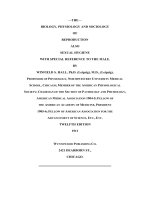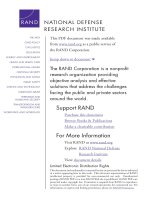Evaluating Novel Threats to the Homeland doc
Bạn đang xem bản rút gọn của tài liệu. Xem và tải ngay bản đầy đủ của tài liệu tại đây (864.55 KB, 130 trang )
This document and trademark(s) contained herein are protected by law as indicated
in a notice appearing later in this work. This electronic representation of RAND
intellectual property is provided for non-commercial use only. Unauthorized
posting of RAND PDFs to a non-RAND Web site is prohibited. RAND PDFs are
protected under copyright law. Permission is required from RAND to reproduce,
or reuse in another form, any of our research documents for commercial use. For
information on reprint and linking permissions, please see RAND Permissions.
Limited Electronic Distribution Rights
Visit RAND at www.rand.org
Explore RAND National Defense
Research Institute
View document details
For More Information
This PDF document was made available
from www.rand.org as a public service of
the RAND Corporation.
6
Jump down to document
THE ARTS
CHILD POLICY
CIVIL JUSTICE
EDUCATION
ENERGY AND ENVIRONMENT
HEALTH AND HEALTH CARE
INTERNATIONAL AFFAIRS
NATIONAL SECURITY
POPULATION AND AGING
PUBLIC SAFETY
SCIENCE AND TECHNOLOGY
SUBSTANCE ABUSE
TERRORISM AND
HOMELAND SECURITY
TRANSPORTATION AND
INFRASTRUCTURE
WORKFORCE AND WORKPLACE
The RAND Corporation is a nonprofit
research organization providing
objective analysis and effective
solutions that address the challenges
facing the public and private sectors
around the world.
Purchase this document
Browse Books & Publications
Make a charitable contribution
Support RAND
This product is part of the RAND Corporation monograph series.
RAND monographs present major research findings that address the
challenges facing the public and private sectors. All RAND mono-
graphs undergo rigorous peer review to ensure high standards for
research quality and objectivity.
Prepared for the Defense Threat Reduction Agency
Approved for public release; distribution unlimited
NATIONAL DEFENSE RESEARCH INSTITUTE
EVALUATING
NOVEL THREATS
TO THE HOMELAND
UNMANNED AERIAL VEHICLES
AND CRUISE MISSILES
Brian A. Jackson, David R. Frelinger
Michael J. Lostumbo, Robert W. Button
The RAND Corporation is a nonprofit research organization providing
objective analysis and effective solutions that address the challenges
facing the public and private sectors around the world. RAND’s
publications do not necessarily reflect the opinions of its research clients
and sponsors.
R
®
is a registered trademark.
© Copyright 2008 RAND Corporation
All rights reserved. No part of this book may be reproduced in any
form by any electronic or mechanical means (including photocopying,
recording, or information storage and retrieval) without permission in
writing from RAND.
Published 2008 by the RAND Corporation
1776 Main Street, P.O. Box 2138, Santa Monica, CA 90407-2138
1200 South Hayes Street, Arlington, VA 22202-5050
4570 Fifth Avenue, Suite 600, Pittsburgh, PA 15213-2665
RAND URL:
To order RAND documents or to obtain additional information, contact
Distribution Services: Telephone: (310) 451-7002;
Fax: (310) 451-6915; Email:
Library of Congress Cataloging-in-Publication Data is available for this publication.
ISBN 978-0-8330-4169-2
Cover Design by Stephen Bloodsworth
The research described in this report was prepared for the Defense
Threat Reduction Agency. The research was conducted in the RAND
National Defense Research Institute, a federally funded research and
development center sponsored by the Office of the Secretary of Defense,
the Joint Staff, the Unified Combatant Commands, the Department
of the Navy, the Marine Corps, the defense agencies, and the defense
Intelligence Community under Contract W74V8H-06-C-0002.
iii
Preface
Deciding how to invest homeland security resources wisely in the
United States can often appear to be an intractable problem because
the large, open American society seems to be so vulnerable to so many
threats in every corner of the country. is monograph is intended to
help bound the problem in order to aid policy and resource decisions
about one type of potential threat to the homeland: cruise missiles
and unmanned aerial vehicles (UAVs). Importantly, the methodology
used can be applied to other modes of attack, and the insights gained
from this methodology extend to other threats as well. e focus of
the research is on a specific class of weapons, but those weapons are
not assessed in isolation; rather, it considers class of weapons as one of
many options open to a potential attacker and seeks to identify invest-
ment strategies that are effective against multiple threats.
is monograph should be of interest to homeland security poli-
cymakers, military and defense planners, analysts examining the ter-
rorist threat, technology and defense system designers, and individuals
charged with protecting potential targets in the U.S. homeland from
terrorist attack.
is research was sponsored by the Defense reat Reduction
Agency (DTRA) and conducted within the International Security and
Defense Policy Center of the RAND National Defense Research Insti-
tute, a federally funded research and development center sponsored
by the Office of the Secretary of Defense, the Joint Staff, the Uni-
fied Combatant Commands, the Department of the Navy, the Marine
Corps, the defense agencies, and the defense Intelligence Community.
For more information on RAND’s International Security and
Defense Policy Center, contact the Director, James Dobbins. He can
be reached by email at ; by phone at 703-413-1100,
extension 5134; or by mail at RAND, 1200 South Hayes Street, Arling-
ton, Virginia 22202. More information about RAND is available at
www.rand.org.
iv Evaluating Novel Threats to the Homeland
v
Contents
Preface iii
Summary
xiii
Acknowledgments
xix
Abbreviations
xxi
CHAPTER ONE
Introduction 1
Unmanned Aerial Vehicles and Cruise Missiles: Technological Change
Producing a Potential reat
2
e RAND Approach
7
Task 1: Conduct a Red Analysis of Alternatives
8
Task 2: Assess the Implications for the Defense
8
About is Report
9
CHAPTER TWO
UAVs and Cruise Missiles as Asymmetric reats: How Do ese
Systems Compare with Alternative Attack Modes?
11
Characteristics of UAVs and Cruise Missiles
14
Comparing the Capabilities of UAVs and Cruise Missiles in Attack
Scenarios to ose of Alternative Attack Modes
16
Direct Attack
18
Indirect Attack
23
Aerial Dispersal
25
Conclusions
25
CHAPTER THREE
What Adversary Operational Problems Can UAVs and Cruise
Missiles Best Solve and How Do UAVs and Cruise Missiles
Compare with Alternative Solutions?
27
1. Enable Attack over Perimeter Defenses
29
Alternative Means for Defeating Perimeter Defenses
31
Assessment of Options for Defeating Perimeter Defenses
35
2. Enable Attack over National Borders
37
Alternative Means for Attacking Across National Borders
39
Assessment of Options for Attacking Across National Borders
41
3. Enable Multiple Simultaneous Attacks
42
Alternative Means for Staging Multiple Simultaneous Attacks
43
Assessment of Options for Staging Multiple Simultaneous Attacks
45
4. Enable an Attack Campaign
47
Alternative Means for Sustaining an Attack Campaign
49
Assessment of Options for Sustaining an Attack Campaign
51
5. Enable Aerial Attack of Area Targets with Unconventional Weapons
52
Alternative Means for Dispersing Weapons over Area Targets
53
Assessment of Options for Dispersing Weapons over Area Targets
55
Conclusions
57
CHAPTER FOUR
What Are the Terrorist Group Characteristics and Preferences
Relevant to the Acquisition and Use of Technology?
61
Access to and Costs Associated with UAV and Cruise-Missile
Technologies
62
Access to and Costs Associated with Alternative Technologies
64
Ability and Willingness to Develop the Expertise Necessary to
Operate the Systems
65
Technological Preferences
66
Conclusions: Two Decisionmaking Pathways
66
Path I
68
Path II
69
vi Evaluating Novel Threats to the Homeland
CHAPTER FIVE
Considering Defensive Strategies and Options 71
Options Available to the Defender
73
Identifying and Catching the Perpetrators: Intelligence, Law
Enforcement, and Forensics
73
Controlling the Spread of UAVs and Cruise Missiles:
Counterproliferation
76
Enabling Targeted Sites to React Before Impact: Detection and
Warning
77
Acting Against the Incoming Weapon or the Launcher: Active
Defenses and Prelaunch Engagement
79
Strengthening Targets to Survive Attack: Passive Defenses
80
Bouncing Back from Attack: Response, Recovery, and
Reconstitution
81
Comparing the Options: Bases for a Blue Analysis of Alternatives
82
How Do the Options Differ in eir Effect on the reat from
UAVs and Cruise Missiles?
83
Do the Options Provide Defensive Benefits with Respect to Other
Forms of Attack Beyond UAVs and Cruise Missiles?
85
How Do the Costs Compare?
86
Are the Solutions Appropriate for the Homeland?
88
Are ere Technical or Organizational Challenges at Might
reaten the Benefits of an Option’s Being Realized?
89
Defense Conclusions: Choosing Among Available Options
89
Deterring Asymmetrtic Use of UAVs and Cruise Missiles?
94
Deterrence by Punishment
94
Deterrence by Denial
95
CHAPTER SIX
Conclusions 97
Anticipating the Attractiveness of a Novel reat to Adversaries
98
Implications for the Defense
98
Bibliography
101
vii
Contents vii
ixix
Figures
2.1. Speed, Platform Weight, Range, and Payload Capacity of
Currently Available UAV and Cruise-Missile Systems
15
2.2. ree Classes of Offensive Application Modes for
Unmanned Aerial Vehicles and Cruise Missiles
17
2.3. Comparison of Alternative Attack Modes
21
3.1. Asymmetric Capabilities Enabled by Unmanned Aerial
Vehicles and Cruise Missiles
28
3.2. Possible Launch Footprints for Sample Petroleum-
Infrastructure Targets for Systems with Ranges of 100,
500, and 1,000 mi
39
4.1. Two-Path Model for Adversary Decisionmaking
68
5.1. Timeline for Defensive Options Against UAVs and Cruise
Missiles, Arrayed Against Attacker Activities
74
5.2. Defensive Approaches and eir Scope Against the
Asymmetric reat from UAVs and Cruise Missiles, for
Comparison
84
xi
Tables
2.1. Estimated Representative Explosive-Charge Sizes for
Relevant Weapon Types
20
3.1. Target Types and Characteristics
29
5.1. Qualitative Order-of-Magnitude Costs of Defensive
Options, for Comparison
87
xiii
Summary
How to invest homeland security resources wisely in the United States
can appear to be an intractable problem because the large, open Ameri-
can society seems to be vulnerable to so many threats in every corner of
the country. is monograph is intended to present a defense-planning
approach to bound the problem and thereby aid policy and resource
decisions about one type of potential threat to the homeland: cruise
missiles and unmanned aerial vehicles (UAVs). e methodology used
can be applied to other modes of attack, and the insights gained from
this approach extend to other threats as well. Indeed, although the
focus of the research is on a specific class of weapons, it does not look
at that class in isolation; rather, it considers the weapons as one of many
options open to a potential attacker and seeks to identify investment
strategies that are effective against multiple threats and weapons.
Cruise missiles and UAVs are the chosen focus of this mono-
graph because they represent important tools in the arsenal of the U.S.
military. e U.S. military has demonstrated their utility in modern
combat in many recent conflicts. erefore, it should not be surpris-
ing that cruise missiles and UAVs are increasingly entering the inven-
tories of militaries around the world, and even those of some terrorist
organizations. Cruise missiles are at times dubbed “the poor man’s air
force”: In some circumstances, they can achieve similar effects to that
of fixed-winged aircraft for a fraction of the cost. And, although per-
haps not as illustrious as ballistic missiles, cruise missiles carry a certain
status for countries and militaries as a milestone in weapon prowess
and technical advancement. But how much of a threat do these capa-
bilities represent?
e difficulty in answering this question stems from intelligence
and law-enforcement organizations’ limited ability to monitor ter-
rorist organizations and uncover new attack modes before they have
been used in an attack. For instance, in July 2006, Hezbollah appar-
ently surprised both Israeli and U.S. intelligence organizations when
it attacked an Israeli naval vessel with a C-802 anti-ship cruise mis-
sile. at limited ability means that, in planning defenses, a traditional
intelligence threat assessment cannot focus only on known or likely
attack modes. Instead, defense planners must consider plausible attack
modes, including weapons that could be transferred from a national
military to a terrorist organization, particularly those that can be oper-
ated by a small number of people and do not require large infrastruc-
ture or support investments.
Assessing how such weapons could be used in attacks in the
United States is also difficult, because there is also an almost infinite
number of targets within the homeland that are vulnerable from the
air and therefore represent possible sites for attack. For such a chal-
lenge as thinking about how to respond to the potential use of these
weapons or the design of defensive approaches, an unbounded prob-
lem becomes intractable: e resource requirements of protecting
everything quickly become staggering. is challenge is further com-
plicated because such weapons represent only one from a variety of
attack options an adversary could choose to use. Before the country
invests in a wide array of cruise-missile or other air-defense assets for
the nation, the problem needs to be bounded so that scarce resources
can be focused productively.
Examining the Threat from UAVs and Cruise Missiles via a
“Red Analysis of Alternatives”
In essence, to assess the threat of cruise missiles and UAVs to the home-
land, we cannot consider them in isolation; instead, we must consider
the problem from the attacker’s point of view, in which these systems
xiv Evaluating Novel Threats to the Homeland
are only one of many ways to stage an attack. We call this approach a
“red analysis of alternatives” because it will consider cruise missiles and
UAVs as one option among many attack possibilities from the point of
view of a potential adversary. As a result, we designed our analysis to
explicitly compare these systems against other ways in which adver-
saries could choose to stage offensive operations and to explicitly test
whether (and in what specific operational situations) UAVs and cruise
missiles provided significant advantages over those alternatives.
e advantages provided by UAVs and cruise missiles over other
attack modes are not in the destructive power that they can carry; they
are in the way they carry that power and the distance from which they
allow an adversary to control its delivery. e value of this advantage to
an adversary and, as a result, the likely attractiveness of these systems
will therefore be driven by the benefits of aerial attack in solving spe-
cific operational problems.
UAVs and cruise missiles are most likely to be attractive in situ-
ations in which their aerial, long-standoff capability solves key opera-
tional problems an attacker faces in planning and mounting an oper-
ation. ese systems appear most advantageous because they could
make it easier for an adversary to do five main things:
attack over perimeter defenses1.
attack over national borders2.
carry out multiple simultaneous attacks3.
conduct an attack campaign (a series of attacks over time)4.
attack area targets with unconventional weapons.5.
Looking specifically at how adversaries can perform these spe-
cific tasks enables analysis of UAVs and cruise missiles in the context
of where their advantages are likely to be most important. rough
such an analysis, it is possible to identify the key characteristics of the
systems that distinguish them from other means of attack and high-
light the specific factors that might lead adversaries to acquire and use
them.
After analyzing cruise missiles and UAVs in their most favor-
able light from the attacker’s perspective, we conclude that they do
Summary xv
not appear to have major advantages over other ways of carrying out
operations against similar targets, although they cannot be dismissed
outright as a potential threat. Where they did appear preferable, the
choice for these systems was driven by the actions of the defense or in-
place security measures—i.e., were alternative attack modes foreclosed
by defenses or did concerns about a potentially compromised plan push
the attacking group farther away from its desired targets? e price
of these advantages was, however, greater complexity, technological
uncertainty, and higher cost and risks associated with these platforms.
Consequently, rather than being an attack mode likely to be widely
embraced by such actors, UAVs and cruise missiles appear to represent
a “niche threat”—potentially making some contribution to the overall
asymmetric and terrorist threat. Cruise missiles and UAVs do provide
some advantages to an attacker, but in most cases there are simpler
alternatives that provide similar, or even superior, capabilities.
Considering Defensive Approaches
In considering appropriate defensive responses to these systems, the
homeland-security planner must weigh the scale of investments that
are appropriate given the nature of the threat they pose. In view of the
availability of alternative attack modes and the uncertainties associ-
ated with the success of cruise missiles and UAVs to adversaries, broad-
based and expensive efforts focused only on this specific threat appear
unrealistic. Given resource constraints, defense planning must there-
fore also include a broad examination of all the defensive options that
are available to craft a prudent and realistic response.
Efforts to defend against this threat could be directed in a wide
variety of ways, ranging from counterproliferation efforts to limit tech-
nology acquisition, to counterterrorism targeting groups’ procuring the
devices, to recovery plans for addressing the consequences of attacks
if they do occur. From a comparison of the options and qualitative
examination of their costs, we conclude that a prudent defensive strat-
egy appropriate to the magnitude of the cruise-missile and UAV threat
would focus primarily on counterterrorism and law enforcement to
xvi Evaluating Novel Threats to the Homeland
prevent attacks and on measures to mitigate the results of such attacks
and quickly recover after they occur. Such an investment will increase
security not only against cruise-missile and UAV attacks but against a
wide variety of potential terrorist attacks.
Some modest defensive investments specific to cruise missiles and
UAVs are called for. e Defense Department and the Intelligence
Community should gather information to help law enforcement iden-
tify potential supply chains and conduct forensics analysis of these sys-
tems. Collection of relevant technology and information to support the
development of better forensics approaches—e.g., acquisition and study
of foreign UAV and cruise-missile systems in ongoing efforts to gather
and exploit technical intelligence—has an important role in building
the foundations needed for post-attack study and for determining any
unique signatures of specific countries’ systems. e key to gaining the
full benefits of such activity is the ability to share relevant information
with law-enforcement organizations.
In addition, diplomatic efforts to strengthen international arms
control regimes, particularly those focused on long-range and large-
payload air vehicles, could make it more difficult for adversaries to
obtain the most destructive of these systems.
In our examination of defensive options, we assessed the potential
for deploying active defenses to shoot down cruise missiles and UAVs;
nevertheless, we do not recommend broadly investing in such defenses
for use in the homeland. Relative to the threat posed by UAVs and
cruise missiles, active defense systems are too costly to operate, can
defend only very small areas, and have limitations even within these
small, defended areas. It is our conclusion that investments in defenses
at the point of attack will take away resources from other more-
productive defense investments focused on preventing a much wider
range of attacks before they occur.
Summary xvii
xix
Acknowledgments
We wish to thank our sponsor, the Advanced Systems and Concepts
Office of the Defense reat Reduction Agency. In particular, Jona-
than D. Fox offered continuing support and interest throughout this
project, and David Hamon had the foresight to see the need for this
research. We also wish to thank our colleague David Mosher of RAND
and Dennis Pluchinsky, a former senior terrorism analyst in the U.S.
Department of State and currently with Transecur, Inc., for reviewing
an earlier draft of this monograph. All shortcomings obviously remain
our responsibility.
xxi
Abbreviations
CBR chemical, biological, and radiological
CM cruise missile
CT counterterrorism
DoD Department of Defense
DTRA Defense reat Reduction Agency
FAA Federal Aviation Administration
FARC Revolutionary Armed Forces of Colombia
GPS Global Positioning System
ICBM intercontinental ballistic missile
INS Inertial Navigation System
ISR intelligence, surveillance, and reconnaissance
kg kilogram
km kilometer
kt knot
lb pound
LE law enforcement
m meter
m
2
meters squared
mi mile
MTCR Missile Technology Control Regime
nmi nautical mile
PIRA Provisional Irish Republican Army
psi pounds per square inch
UAS unmanned aerial systems
UAV unmanned aerial vehicle
WMD weapon of mass destruction
xxii Evaluating Novel Threats to the Homeland
1
CHAPTER ONE
Introduction
Adoption of new technology by adversaries—whether hostile states
or violent nonstate groups—frequently requires that security plan-
ners assess and respond to novel threats. e development of nuclear
weapons in World War II required major adjustments in thinking by
military tacticians, because the shift in environment produced by the
proliferation of those weapons changed the security landscape. e
attacks of September 11, 2001, wherein the use of airliners as weapons
to produce mass casualties shocked traditional views of the capabilities
of nonstate organizations and the nature of the threat they posed, have
similarly challenged established security concepts. In the wake of the
shifts brought about by both these now-historic cases, major efforts
were focused on understanding both what had happened and how the
world had changed, and the reaction to the shifts led to redoubled
efforts at foresight to better understand whether more such shifts were
on the horizon, to prepare for them before they arrived.
Defense planners must assess how a shift in technology or tac-
tics changes the balance in current or potential conflicts. reats with
the potential to be very disruptive may necessitate specific and focused
responses to prevent or hedge against the effects of such disruption.
Responding to each threat in isolation is not free, however. Even in
wealthy nations, resources are finite and development of new responses
to every threat that arises has the potential to spread a defensive effort
thin or to dissipate resources that would be better used in pursuit of
other national goals. Consequently, security planners must examine
new threats to determine what about them is not novel. By explor-









